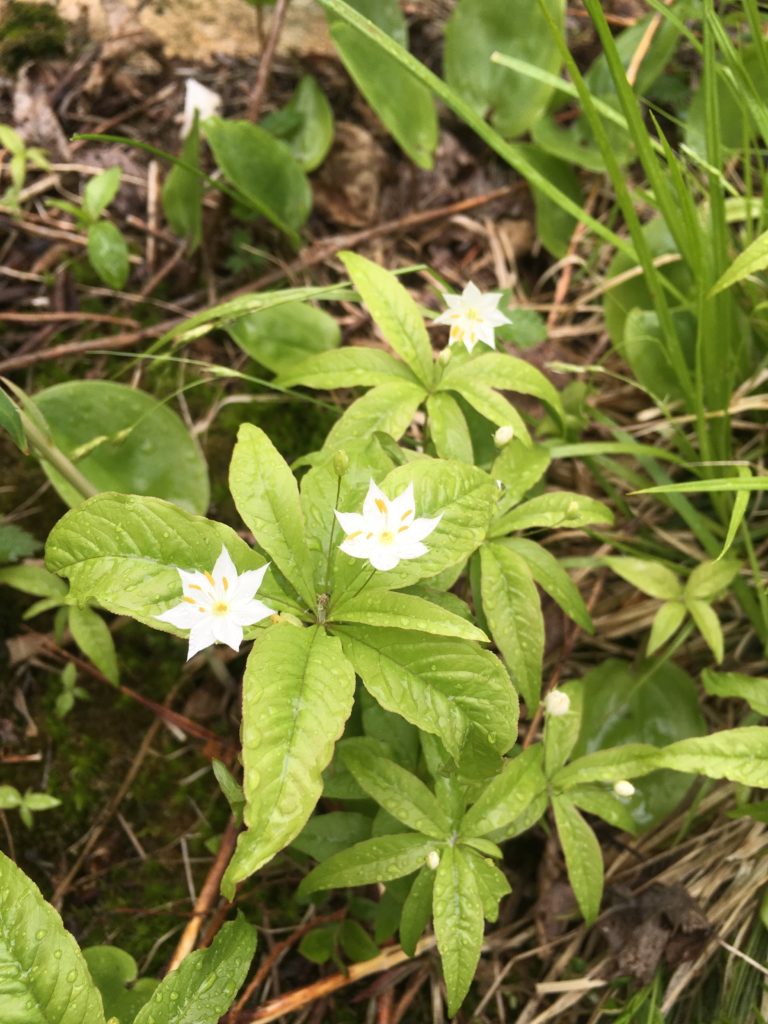Climate Change and Starflower in the Midwest
The Illinois Native Plant Society Research Fund was developed to promote the conservation of Illinois native plants and communities through scientific research.
llinois is nicknamed “The Prairie State,” but many woodland species also make their home here, visible in our forest preserves and other natural areas. One of these species is starflower (Lysimachia borealis), an understory plant with seven-petaled white flowers. Starflower was previously known as Trientalis borealis; the genus name Trientalis means “one-third of a foot,” referring to the height of these tiny plants. Unfortunately, starflower is threatened in Illinois. It only occurs in a few populations in northern Illinois, and populations are small and isolated compared to those in northern Wisconsin, Minnesota and Michigan. It is possible that the wooded places where starflower occurs in Illinois are remnants or “relicts” from a time when the climate was cooler, such as close to the last Ice Age.
If that is the case, are these small starflower populations simply hanging on, doomed to go extinct as the climate warms? Possibly, but hopefully not.

My research, supported by the Illinois Native Plant Society, has been focused on two questions: First, what is the relationship between temperature and starflower phenology? In other words, do the plants flower earlier in warmer climates? Second, how genetically diverse are starflower populations in Illinois? Both of these research questions can aid conservation of this species.
I used data from herbarium specimens dating back to the 1890s and more recent observations from iNaturalist.org. I found that the flowering date of starflower has not shifted over the past 126 years, either in the Midwest or across eastern North America. However, when we look at specific states, the story gets a little more interesting. We do not have enough records from Illinois to detect any trend in flowering time, but in Indiana and Wisconsin, there has not been a shift in the peak date of flowering. Minnesota, on the other hand, does show a significant shift to an earlier flowering date over time. Why is this? The Arctic and northern areas are actually warming faster than other areas—so even within the Midwest, northern Minnesota is warming faster than southern Minnesota (or northern Illinois).
Many plants are flowering earlier in response to climate change, and it can be an issue if pollinators are not responding to the same cues. More of a concern though, is the fact that starflower, a boreal species, doesn’t like to be too hot at night. Previous work showed that during cooler nights, starflower plants can make storage organs (tubers) that will turn into flowering plants the following spring. But warm nights can be physiologically stressful; the plants have to work harder to make energy and have less available to store, resulting in fewer or less vigorous plants the following year.
I have been tracking reproduction of starflower populations in Illinois and Minnesota, and I have found that Illinois starflower populations consistently have fewer flowering plants and lower seed set than populations in Minnesota. The actual percentages vary from year to year, but some Illinois populations have less than 10% of plants setting seed, while in Minnesota, 50% or more of the flowering plants ultimately made seeds. What is the reason for this discrepancy? Are the pollinators not doing their job in Illinois? Or is low seed set due to low genetic diversity?
My students and I are still gathering data to answer this question. What we know so far is that Illinois starflower populations have low genetic diversity, but that doesn’t necessarily mean they’re doomed. We can’t rule out pollinators, because we haven’t studied the pollinators yet. The low genetic diversity we see is not a huge surprise given that starflower is capable of asexual reproduction and sends out rhizomes that produce genetically identical plants. Many plant populations survive with low genetic diversity, but the lack of diversity may hamper the ability of the population to adapt to changing conditions.
For now, we can hope that shady trees and cool Lake Michigan breezes can keep starflower happy enough to maintain the Illinois populations. We will soon know more about the genetic diversity of starflower populations, knowledge that can help with future conservation actions.
